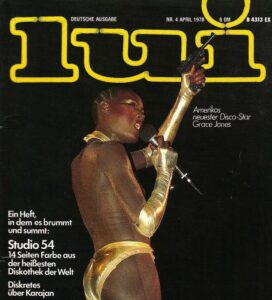Disco Style: Fashion, Glamour & Identity
Disco was never just about music, it was a full-body experience, and no element reflected that more clearly than its fashion. From the glimmer of sequins to the glide of lamé, disco style created a shimmering mirror of the cultural undercurrents pulsing beneath the dancefloor. It wasn’t only about looking good; it was about being seen, celebrated, and free.
In the early 1970s, fashion within the disco scene began evolving alongside the music’s rise. As the clubs became sanctuaries for self-expression and escapism, what you wore wasn’t simply an outfit – it was a declaration. Studio 54’s velvet ropes didn’t separate the elite from the ordinary based on fame or wealth, but on the spectacle of style. If you looked fabulous, you were in. That made fashion a passport to belonging.
Disco style embraced excess unapologetically. Metallic fabrics, plunging necklines, feather boas, wide lapels, and towering platforms blurred the lines between genders and defied the sartorial norms of the decade. For many, these weren’t costumes, they were shields and swords, tools for transformation and liberation.
This liberation manifested not only through bold colors and extravagant designs, but also through provocative choices that directly challenged prevailing norms of modesty. One of the most striking expressions of this liberated fashion was the widespread embrace of sheer fabrics – dresses, tops, and jumpsuits designed to reveal rather than conceal. Transparent garments were worn proudly, often without bras, as an unapologetic statement of body confidence and sensual freedom. In an era when mainstream fashion still imposed rigid norms, the disco dancefloor allowed women (and men) to reclaim their bodies and visibility. The club became a space where sheer clothing shimmered under the lights, turning transparency into both a visual and political statement. Such daring choices were not merely about spectacle, they embodied a deeper reclaiming of personal identity, where one’s style became an act of autonomy and defiance as much as beauty.
Women in the disco era wore outfits that spoke of power, not submission. Diana Ross, Grace Jones, and Donna Summer wore radiant, angular, and futuristic designs that turned the stage into a runway of dominance. Designers like Halston made flowing fabrics and shimmering cuts a symbol of elite glamour, while street fashion brought in DIY creativity with crop tops, flare pants, and glitter makeup. The emphasis was on movement, the body in motion, fabric catching light.

Grace Jones performing at Studio 54 on the cover of Lui Magazine (April 1978); Source: pinterest.com
For the LGBTQ+ community, especially trans and queer people of color, disco fashion offered something even more profound: the opportunity to step into one’s truest self. Drag culture flourished. Androgyny was not just tolerated, it was celebrated. From eyeliner to mustaches, from silk jumpsuits to leather harnesses, the dancefloor became a stage of identity politics in motion.
The influence of Black and Latin culture was paramount. Styles originating in Harlem, the Bronx, and Spanish Harlem spread across cities and into suburban malls, carrying a language of resistance through aesthetic. Afros, bold prints, and gold chains weren’t just fashionable, they were declarations of pride. The fusion of funk, soul, and Caribbean heritage spilled from speakers and wardrobes alike.
Men’s fashion also rebelled. It was suddenly okay – stylish, even, for men to wear silk, open shirts, and tight pants. Masculinity was redefined not through stoicism, but through sensuality and dance. John Travolta’s white suit in ‘Saturday Night Fever’ became an emblem, not of conformity, but of elevation – of someone daring to stand out.
Disco also paved the way for modern fashion in entertainment and nightlife. Rave culture, drag balls, festival fashion, and runway collections by the likes of Versace, Marc Jacobs, and Tom Ford all draw deeply from disco’s original well. Today’s high-glam clubwear and inclusive runway shows owe a clear debt to disco’s fusion of music, light, and unapologetic beauty.
At its heart, disco fashion was an act of joyful resistance. It said: You can’t ignore me. You can’t erase me. Watch me spin.
And decades later, we still do.
CONTINUE EXPLORING THE CULTURAL INFLUENCE AND LEGACY OF DISCO:
• Clubbing Culture & Studio 54
• Disco Style: Fashion, Glamour & Identity
• The Art of the DJ: Turntables as Cultural Icons
• Disco in Film and Television: From “Thank God It’s Friday” to “Pose”
• From New York to the World: Disco’s Global Cultural Spread
• Flyers, Posters and Lightshows: The Visual Language of Disco
SOUND REFLECTIONS:
A few key tracks that not only defined disco’s sound, but shaped how people dressed, moved, and presented themselves, turning the dancefloor into a space where style became an extension of identity and freedom:
-
-
“He’s the Greatest Dancer” – Chic (1979)
The ultimate fashion-disco anthem. Lyrics namecheck Halston, Gucci, Fiorucci, and celebrate sheer, glamorous looks. In the late ’70s, transparent dresses, tops without bras, and high-glamour clubwear were the norm. -
“Fashion Pack (Studio 54)” – Amanda Lear (1979)
An ironic celebration of fashion icons and the Studio 54 elite. The song catalogues designers and jet-set personas as integral to disco culture. -
“Fashion” – David Bowie (1980)
Though post‑disco, this stylish groove laments the excesses of fashion yet celebrates its power, where runway meets rhythmic rebellion. -
“Silver Lady” – David Soul (1977)
With its nod to ‘silver’ glamour, this track’s smooth groove connected well with disco’s opulent, metallic fashion trends. -
“Vogue” – Madonna (1990)
Ballroom culture meets high fashion. Vogueing on the dancefloor blurred the line between dance, modeling, and identity performance.
Through these tracks, fashion wasn’t just seen — it was heard, felt, and lived on the dancefloor, where every look was a statement and every beat an invitation to express it.
Full Spotify playlist: TOP 500 ESSENTIAL DISCO CLASSICS (1972-1979)
-
